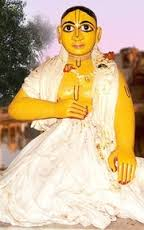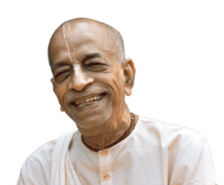
Subject: Sri Vakresvara Pandita Avirbhava Tithi (appearance day)

 śrīvāsa, haridāsa, rāmadāsa, gadādhara
śrīvāsa, haridāsa, rāmadāsa, gadādharamurāri, mukunda, candraśekhara, vakreśvara
e-saba paṇḍita-loka parama-mahattva
caitanyera dāsye sabāya karaye unmatta
SYNONYMS
śrīvāsa—Śrīvāsa Ṭhākura; haridāsa—Haridāsa Ṭhākura; rāmadāsa—Rāmadāsa; gadādhara—Gadādhara; murāri—Murāri; mukunda—Mukunda; candraśekhara—Candraśekhara; vakreśvara—Vakreśvara; e-saba—all of them; paṇḍita-loka—very learned scholars; parama-mahattva—very much glorified; caitanyera—of Śrī Caitanya Mahāprabhu; dāsye—the servitude; sabāya—all of them; karaye unmatta—makes mad.
TRANSLATION
Śrīvāsa, Haridāsa, Rāmadāsa, Gadādhara, Murāri, Mukunda, Candraśekhara and Vakreśvara are all glorious and are all learned scholars, but the sentiment of servitude to Lord Caitanya makes them mad in ecstasy.Sri Caitanya-caritamrta – 1975 Edition : Cc. Adi-lila : Adi 6: The Glories of Sri Advaita Acarya : Adi 6.49-50
vakreśvara paṇḍita–prabhura baḍa priya bhṛtya
eka-bhāve cabbiśa prahara yāṅra nṛtya
SYNONYMS
vakreśvara paṇḍita—of the name Vakreśvara Paṇḍita; prabhura—of the Lord; baḍa—very; priya—dear; bhṛtya—servant; eka-bhāve—continuously in the same ecstasy; cabbiśa—twenty-four; prahara—a duration of time comprising three hours; yāṅra—whose; nṛtya—dancing.
TRANSLATION
Vakreśvara Paṇḍita, the fifth branch of the tree, was a very dear servant of Lord Caitanya’s. He could dance with constant ecstasy for seventy-two hours.
PURPORT
In the Gaura-gaṇoddeśa-dīpikā, verse 71, it is stated that Vakreśvara Paṇḍita was an incarnation of Aniruddha, one of the quadruple expansions of Viṣṇu (Vāsudeva, Saṅkarṣaṇa, Aniruddha and Pradyumna). He could dance wonderfully for seventy-two continuous hours. When Lord Caitanya Mahāprabhu played in dramatic performances in the house of Śrīvāsa Paṇḍita, Vakreśvara Paṇḍita was one of the chief dancers, and he danced continuously for that length of time. Śrī Govinda dāsa, an Oriyā devotee of Lord Caitanya Mahāprabhu, has described the life of Vakreśvara Paṇḍita in his book Gaura-kṛṣṇodaya. There are many disciples of Vakreśvara Paṇḍita in Orissa, and they are known as Gauḍīya Vaiṣṇavas although they are Oriyās. Among these disciples are Śrī Gopālaguru and his disciple Śrī Dhyānacandra Gosvāmī
Sri Caitanya-caritamrta – 1975 Edition : Cc. Adi-lila : Adi 10: The Trunk, Branches and Subbranches of the Caitanya Tree : Adi 10.17 :
āpane mahāprabhu gāya yāṅra nṛtya-kāle
prabhura caraṇa dhari’ vakreśvara bale
SYNONYMS
āpane—personally; mahāprabhu—Śrī Caitanya Mahāprabhu; gāya—sang; yāṅra—whose; nṛtya-kāle—at the time of dancing; prabhura—of the Lord; caraṇa—lotus feet; dhari’-embracing; vakreśvara—Vakreśvara Paṇḍita; bale—said.
TRANSLATION
Śrī Caitanya Mahāprabhu personally sang while Vakreśvara Paṇḍita danced, and thus Vakreśvara Paṇḍita fell at the lotus feet of the Lord and spoke as follows.Sri Caitanya-caritamrta – 1975 Edition : Cc. Adi-lila : Adi 10: The Trunk, Branches and Subbranches of the Caitanya Tree : Adi 10.18
“daśa-sahasra gandharva more deha’ candramukha
tārā gāya, muñi nācoṅ–tabe mora sukha”
SYNONYMS
daśa-sahasra—ten thousand; gandharva—residents of Gandharvaloka; more—unto me; deha’-please deliver; candra-mukha—O moon-faced one; tārā gāya—let them sing; muñi nācoṅ—let me dance; tabe—then; mora—my; sukha—happiness.
TRANSLATION
“O Candramukha! Please give me ten thousand Gandharvas. Let them sing as I dance, and then I will be greatly happy.”
PURPORT
The Gandharvas, who are residents of Gandharvaloka, are celebrated as celestial singers. Whenever singing is needed in the celestial planets, the Gandharvas are invited to sing. The Gandharvas can sing continuously for days, and therefore Vakreśvara Paṇḍita wanted to dance as they sang.
975 Edition : Cc. Adi-lila : Adi 10: The Trunk, Branches and Subbranches of the Caitanya Tree : Adi 10.19
bhāgavatī devānanda vakreśvara-kṛpāte
bhāgavatera bhakti-artha pāila prabhu haite
SYNONYMS
bhāgavatī devānanda—Devānanda, who used to recite Śrīmad-Bhāgavatam; vakreśvara-kṛpāte—by the mercy of Vakreśvara; bhāgavatera—of Śrīmad-Bhāgavatam; bhakti-artha—the bhakti interpretation; pāila—got; prabhu haite—from the Lord.
TRANSLATION
Devānanda Paṇḍita was a professional reciter of Śrīmad-Bhāgavatam, but by the mercy of Vakreśvara Paṇḍita and the grace of the Lord he understood the devotional interpretation of the Bhāgavatam.
PURPORT
In the Caitanya-bhāgavata, Madhya-līlā, Chapter Twenty-one, it is stated that Devānanda Paṇḍita and Sārvabhauma Bhaṭṭācārya’s father, Viśārada, lived in the same village. Devānanda Paṇḍita was a professional reciter of Śrīmad-Bhāgavatam, but Lord Caitanya Mahāprabhu did not like his interpretation of it. In the present town of Navadvīpa, which was formerly known as Kuliyā, Lord Caitanya showed such mercy to him that he gave up the Māyāvādī interpretation of Śrīmad-Bhāgavatam and learned how to explain Śrīmad-Bhāgavatam in terms of bhakti. Formerly, when Devānanda was expounding the Māyāvādī interpretation, Śrīvāsa Ṭhākura was once present in his meeting, and when he began to cry, Devānanda’s students drove him away. Some days later, Caitanya Mahāprabhu passed that way, and when He met Devānanda He chastised him severely because of his Māyāvāda interpretation of Śrīmad-Bhāgavatam. At that time Devānanda had little faith in Śrī Caitanya Mahāprabhu as an incarnation of Lord Kṛṣṇa, but one night some time later Vakreśvara Paṇḍita was a guest in his house, and when he explained the science of Kṛṣṇa, Devānanda was convinced about the identity of Lord Caitanya Mahāprabhu. Thus he was induced to explain Śrīmad-Bhāgavatam according to the Vaiṣṇava understanding In the Gaura-gaṇoddeśa-dīpikā, verse 106, it is described that he was formerly Bhāguri Muni, who was the sabhā-paṇḍita who recited Vedic literature in the house of Nanda Mahārāja.
Sri Caitanya-caritamrta – 1975 Edition : Cc. Adi-lila : Adi 10: The Trunk, Branches and Subbranches of the Caitanya Tree : Adi 10.77
The three brothers Govinda, Mādhava and Vāsudeva Ghoṣa all belonged to a kāyastha family. Govinda established the Gopīnātha temple in Agradvīpa, where he resided. Mādhava Ghoṣa was expert in performing kīrtana. No one within this world could compete with him. He was known as the singer of Vṛndāvana and was very dear to Śrī Nityānanda Prabhu. It is said that when the three brothers performed saṅkīrtana, immediately Lord Caitanya and Nityānanda would dance in ecstasy. According to the Gaura-gaṇoddeśa-dīpikā (188), the three brothers were formerly Kalāvatī, Rasollāsā and Guṇatuṅgā, who recited the songs composed by Śrī Viśākhā-gopī. The three brothers were among one of the seven parties that performed kīrtana when Lord Śrī Caitanya Mahāprabhu attended the Ratha-yātrā festival at Jagannātha Purī. Vakreśvara Paṇḍita was the chief dancer in their party. This is vividly described in the Madhya-līlā, Chapter Thirteen, verses 42 and 43.
Books : Sri Caitanya-caritamrta – 1975 Edition : Cc. Adi-lila : Adi 10: The Trunk, Branches and Subbranches of the Caitanya Tree : Adi 10.115 : PURPORT :
kāśī-miśra, pradyumna-miśra, rāya bhavānanda
yāṅhāra milane prabhu pāilā ānanda
SYNONYMS
kāśī-miśra—of the name Kāśī Miśra; pradyumna-miśra—of the name Pradyumna Miśra; rāya bhavānanda—of the name Bhavānanda Rāya; yāṅhāra—of whom; milane—meeting; prabhu—the Lord; pāilā—got; ānanda—great pleasure.
TRANSLATION
In the list of devotees at Jagannātha Purī [which begins with Paramānanda Purī, Svarūpa Dāmodara, Sārvabhauma Bhaṭṭācārya and Gopīnātha Ācārya], Kāśī Miśra was the fifth, Pradyumna Miśra the sixth and Bhavānanda Rāya the seventh. Lord Caitanya took great pleasure in meeting with them.
PURPORT
In Jagannātha Purī Lord Caitanya lived at the house of Kāśī Miśra, who was the priest of the king. Later this house was inherited by Vakreśvara Paṇḍita and then by his disciple Gopālaguru Gosvāmī, who established there a Deity of Rādhākānta. The Gaura-gaṇoddeśa-dīpikā (193) states that Kāśī Miśra was formerly Kubjā in Mathurā.. Pradyumna Miśra, an inhabitant of Orissa, was a great devotee of Lord Caitanya Mahāprabhu. Pradyumna Miśra was born of a brāhmaṇa family and Rāmānanda Rāya of a non-brāhmaṇa family, yet Lord Caitanya Mahāprabhu advised Pradyumna Miśra to take instruction from Rāmānanda Rāya. This incident is described in the Antya-līlā, Chapter Five.
Bhavānanda Rāya was the father of Śrī Rāmānanda Rāya. His residence was in Ālālanātha (Brahmagiri), which is about twelve miles west of Jagannātha Purī. By caste he belonged to the karaṇa community of Orissa, whose members were sometimes known as kāyasthas and sometimes as śūdras, but he was the governor of Madras under the control of King Pratāparudra of Jagannātha Purī.Books : Sri Caitanya-caritamrta – 1975 Edition : Cc. Adi-lila : Adi 10: The Trunk, Branches and Subbranches of the Caitanya Tree : Adi 10.131
cakravartī śivānanda sadā vrajavāsī
mahāśākhā-madhye teṅho sudṛḍha viśvāsī
SYNONYMS
cakravartī śivānanda—of the name Śivānanda Cakravartī; sadā—always; vraja-vāsī—resident of Vṛndāvana; mahā-śākhā-madhye—amongst the great branches; teṅho—he is; sudṛḍha viśvāsī—possessing firm faith.
TRANSLATION
Śivānanda Cakravartī, the thirty-third branch, who always lived in Vṛndāvana with firm conviction, is considered an important branch of Gadādhara Paṇḍita.
PURPORT
The Gaura-gaṇoddeśa-dīpikā, verse 183, mentions that Śivānanda Cakravartī was formerly Lavaṅga-mañjarī. The Śākhā-nirṇaya, written by Yadunandana dāsa, also names other branches of Gadādhara Paṇḍita, as follows: (1) Mādhava Ācārya, (2) Gopāla dāsa, (3) Hṛdayānanda, (4) Vallabha Bhaṭṭa (the Vallabha-sampradāya, or Puṣṭimārga-sampradāya, is very famous), (5) Madhu Paṇḍita (this famous devotee lived near Khaḍadaha in the village known as Sāṅibonā-grāma, about two miles east of the Khaḍadaha station, and constructed the temple of Gopīnāthajī in Vṛndāvana), (6) Acyutānanda, (7) Candraśekhara, (8) Vakreśvara Paṇḍita, (9) Dāmodara, (10) Bhagavān Ācārya, (11) Ananta Ācāryavarya, (12) Kṛṣṇadāsa, (13) Paramānanda Bhaṭṭācārya, (14) Bhavānanda Gosvāmī, (15) Caitanya dāsa, (16) Lokanātha Bhaṭṭa (this devotee, who lived in the village of Tālakhaḍi in the district of Yaśohara and constructed the temple of Rādhāvinoda, was the spiritual master of Narottama dāsa Ṭhākura and a great friend of Bhūgarbha Gosvāmī), (17) Govinda Ācārya, (18) Akrūra Ṭhākura, (19) Saṅketa Ācārya, (20) Pratāpāditya, (21) Kamalākānta Ācārya, (22) Yādava Ācārya and (23) Nārāyaṇa Paḍihārī (a resident of Jagannātha Purī).
ri Caitanya-caritamrta – 1975 Edition : Cc. Adi-lila : Adi 12: The Expansions of Advaita Acarya and Gadadhara Pandita : Adi 12.88 :
